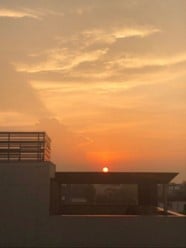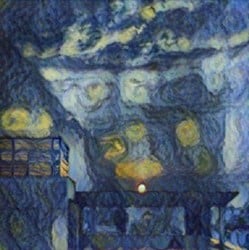While we wait for further guidance on the registrability of the art output by generative artificial intelligence (AI) models, the U.S. Copyright Office is forging ahead with new decisions that address the issue. On Dec. 11, 2023, the Copyright Office's Review Board rejected an artist's attempt to register his "2-D artwork" – now the fourth such case to date.
Artist Ankit Sahni started off by snapping an original photograph that captures the sun, surrounded by orange-tinted clouds, just beginning to dip below the roofline of a building. Mr. Sahni input his photograph into an AI painting app, RAGHAV, along with a copy of Vincent van Gogh's The Starry Night as the style to be applied to his photograph. A third input was Mr. Sahni's choice of the degree of style for RAGHAV to transfer.


Original photograph SURYAST
The above output, titled SURYAST, is recognizable as a heavily stylized version of the original photograph. The sun remains the focal point, the clouds swirl in patterns, and the building in the foreground is complete with its slatted privacy fence.
In his application to register a copyright to the work, Mr. Sahni listed himself and RAGHAV as co-authors. The reason being, he explained, was that the AI's contribution is "distinct, disparate and independent" from his contribution.
As it has done in similar cases, surveyed below, the Copyright Office refused to register the work. The Copyright Office ruled that the work "lacked the human authorship necessary to support a copyright claim."
After a first request for reconsideration, the Copyright Office explained that the work was a "classic example of derivative authorship because it was a digital adaptation of a photograph." A derivative work contains two forms of authorship: one in the preexisting work and another in the modification of the preexisting work. (See U.S. Copyright Office, Compendium of U.S. Copyright Office Practices § 507.1 (3d ed. 2021).) Authorship in the modification of a work is registrable if it contains a sufficient amount of original, human authorship. (See id; "Copyright Registration Guidance: Works Containing Material Generated by Artificial Intelligence," 88 Fed. Reg. 16,190, 16,192 (March 16, 2023).) In this case, because the modification was attributable to RAGHAV, there was no human author and the work was not registrable. Moreover, the Copyright Office noted that even if RAGHAV was removed as an author on the application, its conclusion would not change.
Mr. Sahni based his second request for reconsideration on three arguments. First, Mr. Sahni changed his position to say that RAGHAV was an "assistive software tool" – akin to Adobe Photoshop and subject to his control – instead of an independent author. Second, Mr. Sahni's artistic contributions included composing the original photo and selecting it for input, as well as selecting the style to be applied and the degree of stylization. Third, the work was not derivative because the original photograph was just an early stage of what would become the final work, like a painter making a sketch before completing a painting.
The Copyright Office's Review Board was not amenable to Mr. Sahni's arguments. The board ruled that RAGHAV's role could not be minimized because the AI, not Mr. Sahni, was responsible for interpolating the images. The board further concluded that RAGHAV accomplished this based on its training, not Mr. Sahni's selection of inputs (which by itself was merely an unprotectable idea – not a protectable expression of an idea). In other words, Mr. Sahni's creative input only amounted to the concept of his photograph in the style of The Starry Night, something which copyright law did not protect, whereas a protectable expression of his concept would be Mr. Sahni putting ink to canvas.
Prior Cases
Below is a survey of recent copyright cases relating to generative AI producing creative works. The facts of each case differ slightly, yet the existing cases all reach the same outcome: output from generative AI is not copyrightable.
- A Recent Entrance to Paradise, August 2022: As covered in a July 26, 2022, Holland & Knight IP/Decode Blog post, the U.S. Court of Appeals for the Federal Circuit affirmed the denial of Dr. Stephen Thaler's application to copyright an AI-generated work. He had alleged that his self-developed AI model, Creativity Machine, autonomously created the work and listed the AI as the sole author of the work.
- Zarya of the Dawn, February 2023: Covered in a Dec. 15, 2022, Holland & Knight Masters of the Metaverse Blog post, as well as a May 2, 2023, Holland & Knight IP/Decode Blog post, Kristina Kashtanova initially received a copyright to her graphic novel, but the Copyright Office ultimately cancelled the registration with respect to the images included in her novel because they were created using Midjourney, a text-to-image AI program.
- Théâtre D'opéra Spatial, September 2023: The Review Board rejected Jason Allen's attempt to register his award-winning work. Mr. Allen had input at least 624 different prompts into Midjourney to get an initial image, then used Photoshop to remove flaws and add visual elements, and finally used Gigapixel AI to "upscale" the image. The Review Board determined that the visual edits made with Photoshop potentially contained a sufficient amount of original human authorship to be registered. But on the other hand, Midjourney's output and Gigapixel AI's contribution would have to be disclaimed as more than de minimis non-human authorship. (See Copyright Registration Guidance, 88 Fed. Reg. at 16,193.) Mr. Allen refused to do so.
The Cases Provide a Preview of What May Come Next
Footnotes contained in the SURYAST and Théâtre D'opéra Spatial decisions veer into the realm of the hypothetical and invite new technical facts that may affect copyrightability outcomes.
Footnotes 5 and 6 in the SURYAST decision discuss the lack of detailed evidence in the record as to how RAGHAV was designed and by whom (although RAGHAV was named for the engineer who developed the app for Mr. Sahni, Raghav Gupta). The Copyright Office, however, only had the vague description that RAGHAV was trained on a dataset of 14 million base images, called ImageNet, and then on another dataset of "content and style" images.
These footnotes may invite cases where the artist designs the AI model themselves, like Dr. Thaler and his Creativity Machine, and details their involvement in that design process to the Copyright Office. If Mr. Sahni had designed RAGHAV and carefully selected its training materials, would that (in combination with taking the original photograph and selecting the style applied) constitute enough "creative control" for Mr. Sahni to assert authorship in the modification? Or would the Copyright Office still consider the output to be controlled by "outside forces," similarly to how "a garden owes most of its form and appearance to natural forces, though the gardener who plants and tends it obviously assists." (See "U.S. Copyright Office, Second Request for Reconsideration for Refusal to Register Théâtre D'opéra Spatial" at 7 n.11 (quoting Kelley v. Chicago Park District, 635 F.3d 290, 304 (7th Cir. 2011).)
If such a change in facts indeed made Mr. Sahni the author of the modifications, would that allow the companies who develop generative AI models achieve dominance in the space?
Footnote 5 of the Théâtre D'opéra Spatial decision notes that there may be future cases in which the artist claims that the modification made by the AI model is de minimis and thus need not be disclaimed (imagine Mr. Sahni selecting the degree of Starry Night stylization to be applied as a "1" on a scale from 1 to 1,000). In those cases, the artist would be asserting authorship over the whole output. Would the AI model's role then be sufficiently reduced to that of an "assistive software tool"?
We may see these facts adjudicated soon, given the rapid evolution of creative generative AI coupled with individuals' willingness to test the limits of copyrightability.